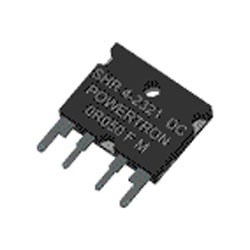New Precision Foil Current-Sense Resistors Combine Low TCR With Ratings To 80W

VPG has introduced the first seven devices in its new S Series of precision foil current-sense resistors. Offering a TCR of ±2 ppm/C – the industry’s lowest for high-power current shunts – the SHR, SHS, SNR, and SPR devices provide power ratings to 80W in a variety of epoxy packages, says the company.
The resistors offer a wide range of power ratings – from 1.5W in free air to 80W when mounted on a heatsink – with low resistance values from 0.002ohm to 50ohm and tight tolerances to ±0.1%. The devices feature maximum currents to 150A, with higher values available on request; very low inductance; thermal EMF of <1µV/C ; and a temperature range of -40C to +130C.
Providing exceptional load-life stability of ±0.1% typical after rated power at 70C for 2,000 hours, S Series resistors provide highly accurate and reliable current sensing in power supplies, digital multimeters, current control systems, medical equipment, solar and wind inverters, AC/DC converters, and battery chargers. The RoHS-compliant devices are available in a wide range of package sizes, including the standard TO-220 and surface-mount version.
“Several years ago Powertron decided to focus on developing resistive current sense devices with Kelvin connections that would allow quick and accurate current measurements,” said Yuval Hernik, senior director of application engineering for VFR. “Current sensing circuits provide the data control that circuits need to operate properly, and foil resistors are among their fundamental building blocks. In the typical application, a controlling circuit monitors current flowing through a current sense resistor as a voltage drop across the resistor and directs parameter changes to ensure that optimum circuit performance is maintained.”
Every current sense resistor must have an error budget assigned to it. If this budget is exceeded, equipment will fall out of its performance specification, or possibly fail. In addition to initial tolerance, the error budget includes allowable shifts through shelf life, assembly, TCR, shock, vibration, thermal shock, thermal EMF, and load-life drift. Designers then need to select a particular resistor technology with the least amount of change through all the stresses, add up all the expected Δ Rs, and subtract these from the end-of-life tolerance limit to arrive at the purchase tolerance. This needs to be kept in mind when considering the overall long-term costs of a system, and the consequences of attempting to save on upfront assembly costs. Precision current sense resistors with the same resistance, tolerance, and TCR – but of different technologies – are not interchangeable, as the changes through their service life are not the same. Substitution on the basis of these alone could jeopardize performance and mission success, says the company.
“Today we see more and more attempts by certain electronic manufacturing services to replace precision current sense resistors with cheaper solutions that put system performance at risk,” added Hernik. “Designers utilizing current sense resistors for critical applications should demand specific data from their suppliers to be certain that the resistors are exactly what are needed. The data should cover the resistance values required by the circuit as much as possible, and one should not assume that all resistors of a particular style, configuration, or technology have the same implied reliability.”
Source: Vishay Precision Group
